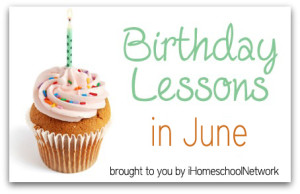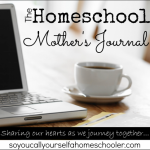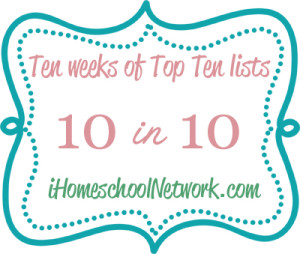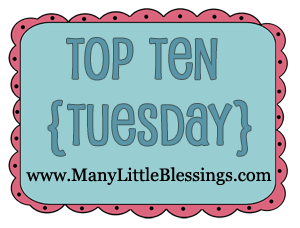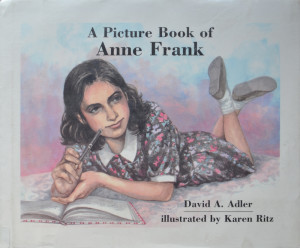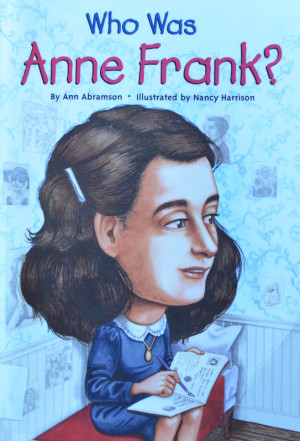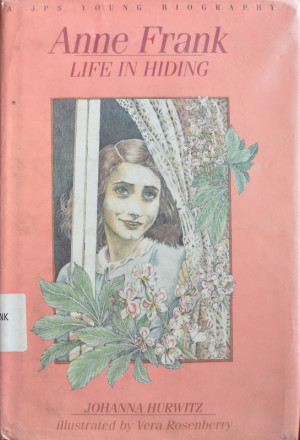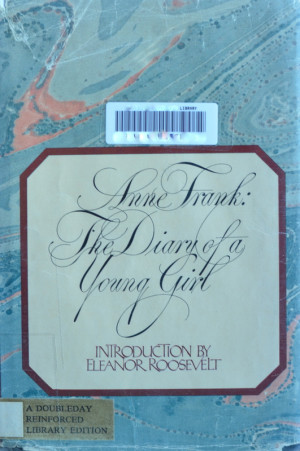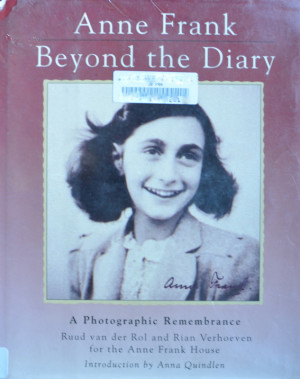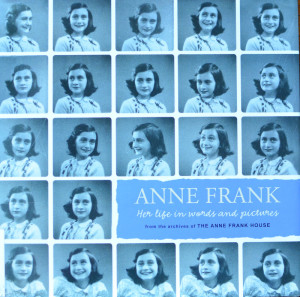 Hi, I'm Heidi and I homeschool my two sweet kids. I want them to know that learning is an exciting lifelong adventure! We love great books, unit studies, notebooking, lapbooking, and hands-on learning.
Hi, I'm Heidi and I homeschool my two sweet kids. I want them to know that learning is an exciting lifelong adventure! We love great books, unit studies, notebooking, lapbooking, and hands-on learning.Successful Start to Summer Schooling
Summer school is fully underway, hooray! I’ve made my notes to just leave June alone next year, and plan on a July start of more structured learning. That way I don’t feel “late” or “behind.”
We’ve been using the weekly checklists I made for the kids since early June and earlier this month started working away at our summer curriculum plans. I purposefully didn’t plan a lot of formal schoolwork, but tried leaving us open for relaxed learning. As a die-hard planner I wondered if this would work or if learning wouldn’t happen if I didn’t have it all written in my lists. The good news is we’ve learned a lot without me planning and directing everything! (Shocker, I know.)
Nature Study
Two new-to-us insects from nature found us this week:

My father-in-law brought this magnificent luna moth specimen to us. He shared a lot of information with us, and I later found this YouTube video of the luna moth life cycle that has wonderful footage of the moth and equally wonderful explanations of all the things that make it so interesting! We realized how lucky we were to see one, since they are nocturnal and adults only live one week. By the way, the adult luna moth doesn’t eat–at all. It comes out of the cocoon just to reproduce and die.

Another day I was mowing and noticed these wart-like growths on some maple leaves. I envisioned a crawly little insect or worm hatching out, so we put a few leaves in the bug catcher for observation…nothing happened. After a Google search I discovered they were galls formed by a mite that overwinters in the bark of the tree. The leaf produces the little pouch-like galls that surround the mite, which continues to live, feed, and breed within the gall. Luckily it isn’t likely to damage the trees. Insects are fascinating!
Science
We attended a Mad Science presentation sponsored by our library called “Dig Into Science: Journey to the Center of the Earth.” It was an interactive, action-packed hour where we all learned a little something.
Reading Aloud
We have been completely entranced by the Chronicles of Narnia. I’m reading the books aloud (starting with The Magician’s Nephew) and after we finish each one we’re listening to the radio dramatization from Focus on the Family (which is superb, by the way). I really wanted to read the series, but was a bit worried after all of us disliked The Hobbit. I wondered if we were fantasy-challenged but we all love this story.
Educational Television Viewing
My daughter has always enjoyed the “Dear America” books, and we stumbled across Dear America videos on Netflix. There are 12 half-hour episodes: nine are historical fiction stories from American history, three are the “Royal Diaries” versions that tell of a famous princess. I highly recommend them! They’re perfect for relaxed summer learning and have led to great discussions and role-playing the characters and time periods in their free time.
And a side note: I’ve talked about learning to loosen up on my themes and let go of my constant attempts to keep topics neatly grouped together. The old me would have written down this great resource and tried to use each video at its appropriate time in our history studies. The I’m-still-learning-to-let-go me not only let my children go ahead and watch Cleopatra (even though we’ll be studying her next school year) but I didn’t even require they watch the videos in order chronologically. How’s that for progress?
We are enjoying our new favorite science show, Mythbusters (many episodes also available on Netflix). My son loves the show and it really inspires him to experiment. For instance, on one show they were testing vehicles in tornado-force winds. The rest of the afternoon my son built Lego vehicles and tested them in wind. We played around with fans and a blow dryer to get the strongest wind. (And when I heard the leaf blower of the lawn company working down the street the crazy homeschool mom in me was tempted to ask to borrow it.)
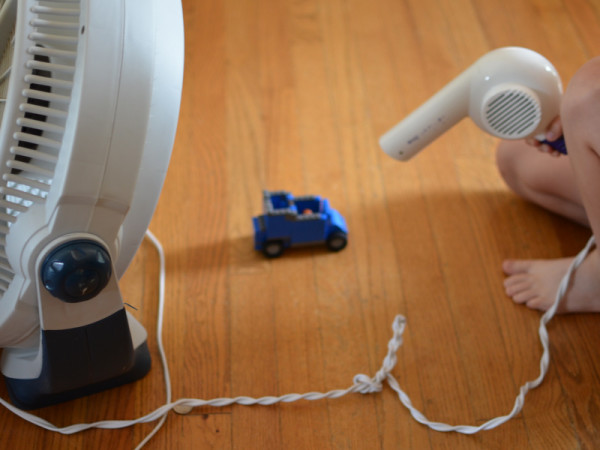
My favorite part of the show is how they model that everything doesn’t always work perfectly on your first try–often something fails and you have to try and try again!
Art
I shared our wire sculpting based on the book Norman the Doorman. Trying out a completely new art medium was great fun for all of us.
I have another homeschool experiment–if less planning can still mean a lot of learning, will this work in the area of art, too? Our art supplies are conveniently located in a big hutch near our kitchen, but neither of my children tends to get them out unless I’m directing a specific art project. I tried a little experiment one hot afternoon and got out the watercolor paints, telling them to paint whatever they wanted.
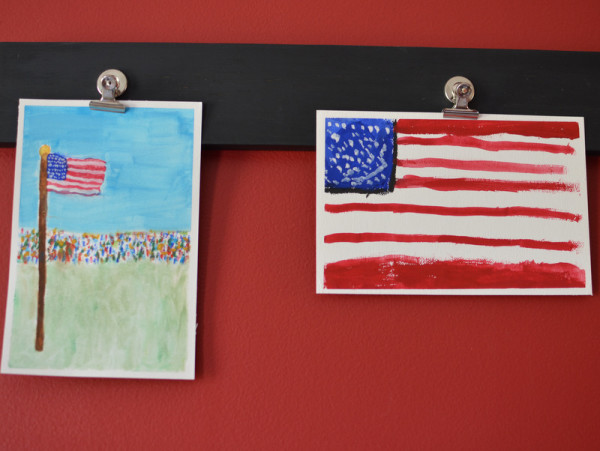
It worked wonderfully! This isn’t to say that I don’t want to do art projects with instructions for learning skills, but I think I’ve overlooked the importance of also giving them time to just create on their own.
And All The Other Things That Summer Brings!
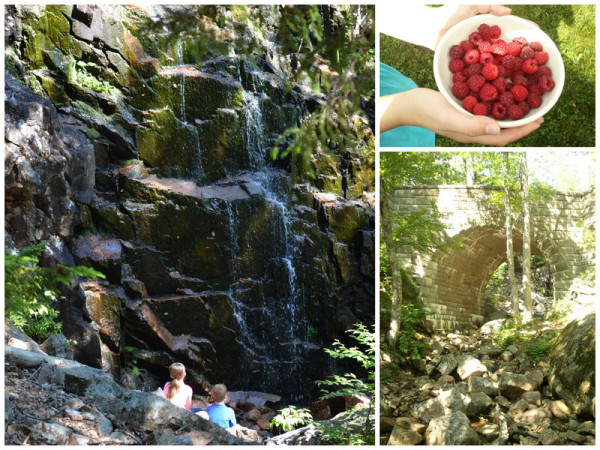
We hiked to a waterfall in Acadia National Park, walking on the historic carriage roads part of the way. Our summer goal is 10 new adventures, meaning a hike or visit to a lighthouse we’ve not seen before. This is number three checked off! I feel good about that progress. And speaking of progress, we’re beginning to see some produce from our gardens. Not enough to make jam or anything, but some raspberries made a delicious snack!
Have you been working on summer goals, either educational or just for fun?
Thank you to the wonderful hostesses with wrap-up link-ups. Be sure to join the fun and see what other homeschoolers are up to!
2013 Summer School Plans
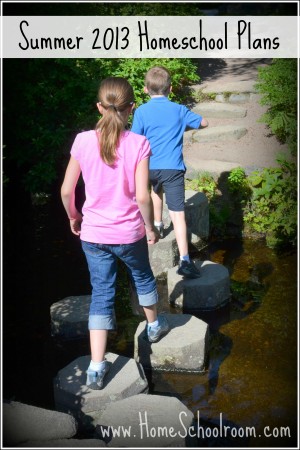
It’s our third year of summer schooling since that first summer we started our homeschool journey.
Our first summer we did a few big unit studies: the Revolutionary War, wildflowers and the ocean. They were a fun start to homeschooling with my little almost six year old boy who didn’t want to sit still and my barely 9 year old who had just finished public school second grade.
Our second summer I planned too much: some core curriculum work for both kids along with beginning full science and history curricula that I planned to continue with in the fall. It wasn’t a bad summer, but I never felt I got as much done as I wanted and just continuing on with those same items in the fall wasn’t a very refreshing transition.
So here we are in summer number three. I love year round schooling, but I’m taking a bit more relaxed approach this summer. Though I’m always adjusting in our homeschool I felt ready for some real examination of my techniques and tactics before next year. A few things need tweaking as we grow into our homeschool skin and my daughter enters the middle school years. I’ve been reading and re-reading and thinking and re-thinking. In the meantime I’m taking it fairly light on formal schoolwork for the summer.
Independent Summer Schoolwork
Both Kids
We’re making good progress on making their chores and certain responsibilities happen without a lot of reminders from me using our summer schedules.
11 Year Old Daughter
On her checklist for schoolwork she is required to read and practice piano daily, do XtraMath and typing twice a week, and we’re starting a Life of Fred Fractions lesson once a week. She uses Teaching Textbooks during the year, so we’re trying LOF as a fun summer supplement.
7 Year Old Son
My son’s biggest goal is to practice reading! After finishing Funnix (my review on Curriculum Choice here) I kept fretting about whether he needed more formal curriculum for reading. He just wants to read, and read fun books (not leveled readers with a boring story). A post by one of my favorite bloggers, Heather of Blog She Wrote, reassured me that just reading is the best next step. So that’s what we do nearly every day. And I still read to him from both picture and chapter books.
What We’ll Work on Together
History
We’ve just started What Every Child Needs to Know about Western Civilization from Brimwood Press. So far I’m really impressed by this ingenious history program. We’re spreading this out over the summer, and it is a perfect break from our labor intensive history studies. This is open-and-go for me: just some reading aloud and looking at pictures is giving us a better view of the overall flow of history. Lovely. (I’ll write a full review soon.)
Science
We were so history-focused last year that my science-loving son has asked for more science. Especially experiments that call for goggles. So here we go! This may look like a lot, but they’re all just flexible topics that we do when time and desire presents itself.
- Nature Study: Okay, so we don’t usually need goggles in nature study, but my boy does love bugs and the outdoors. We’ll continue to use Barb’s ideas at the Handbook of Nature Study blog (be sure to subscribe so you get her newsletter) and just try to dive in and learn about things that find us.
- Snap Circuits: My son is also quite tech-obsessed, so we’re working through a study of electricity with lots of hands-on fun using our Snap Circuits kit. I wrote a review on Curriculum Choice of the kit and the student guide we’re using.
- Human Body: I have a bunch of resources for a human body study that I pulled together last fall when my kids were asking questions about how our bodies work. I hate to say all the great books did nothing but sit on the shelf, but I hope to crack them open this summer. My approach will be more relaxed than what I first planned: pretty much read and look at pictures, and do a fun hands-on observation, dissection, or experiment when they’re interested and it’s easy. I think a few could involve goggles.
Art
I’m planning to jump in for another great resource from Barb, also known as Harmony Art Mom. She usually posts Sketch Tuesday assignments with a topic to draw. This summer she’s posting all kinds of different art projects, and anyone is free to send in photos of their finished work and she puts them all in a slideshow.
Another goal for art this summer is to just get out the supplies once in a while and let them create without direction from me. Crazy, huh?
Reading Aloud
I think the thing I will miss most when my children grow up and move out is reading aloud together. I know my daughter, at 11 years old, still looks forward to our reading times. Our first (big) goal is the entire Chronicles of Narnia…we’re already on the second book and loving it.
So that’s the plan. An hour here and there throughout the week accomplishes our relaxed summer learning, with lots of time left for being outside, camping, swimming, hiking, playing, creating, and following interests as they come up.
10 Unexpected Benefits to Homeschooling
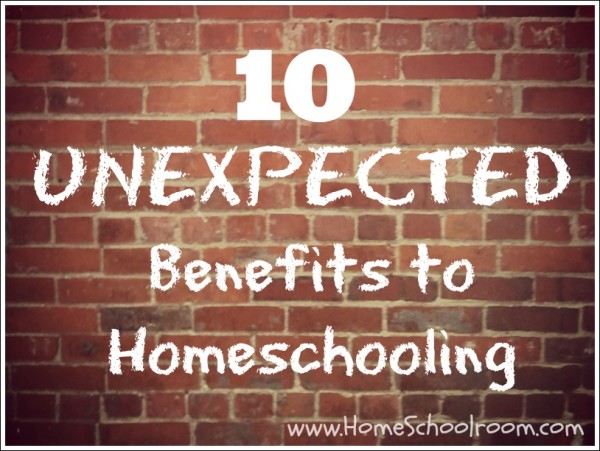
Before I started actually homeschooling I had dreamy visions of how it would go. I shared now slightly humorous visions and the reality of homeschooling. So if it isn’t the perfect scenario I envisioned, why do I still homeschool? Because the good outweighs the bad by a ton.
The basic benefits I hoped for when researching homeschooling have held true: lots of family time together and a tailored education for both my children. But there are even more benefits than I had anticipated. It’s not to say that I hadn’t thought of some of these, but the degree of delightfulness had been unexpected.
#1. I hadn’t realized the full impact of not only lots of time together but all this shared learning.
I was hoping homeschooling would strengthen our family bonds, but it has had an unbelievable affect on our family culture. We’re always reminding each other of funny stories or using quotes from books we’ve read together. So many more of our memories are shared memories. I especially see this having a great impact on the relationship between my kids since we read aloud and study many subjects together. Being a boyish boy and girly girl three years apart, learning together gives them helpful things in common: often they spend free time reenacting a wagon train, a story about Cleopatra, or something else we’ve been studying.
#2. I know what my kids have been learning.
When my daughter was in school I got the report of the day by looking over her papers or whatever she happened to remember to tell me (which was often more about the social aspects). But as their homeschool teacher I know what they’ve been studying. I can tie prior knowledge into something else we’re doing. When we’re at a lighthouse and the man starts talking about the remains of a fort that was once occupied by the British I can tie that in to things we’ve studied!
#3. The flexibility is amazing!
Okay, I did look forward to the flexibility of homeschooling before we started, but the number of ways in which it benefits us surprised me. My early riser does his best focused schoolwork early, so we can schedule his work accordingly. If it’s hot we get outside early in the day, not take recess at 12:30 even if it’s 80 degrees then. We can hike on a nice Thursday and finish schoolwork on a rainy Saturday. We can go places when they aren’t as busy. If any or all of us is just having one of those tough days we can take a break and reboot. The kids have more time with their Dad (who works irregular hours) and even their grandparents. We just can be flexible (and often still learning!) while we’re sick and not worry about how soon I can send them back to school.
#4. My kids are being better prepared for taking care of themselves and a home.
My kids are learning and doing more household chores because they are home a lot. (That isn’t to say that my home is cleaner than before homeschooling because, well, we’re home a lot and make a lot of messes!) But instead of rushing off in the morning and returning in the evening to see a stocked fridge and laundered clothes in a tidy house, they are there all day. They run to the store with me, we fold clothes together while reading, and we all participate in household chores. They are seeing the responsibilities of adults and learning to do them right alongside me.
#5. There’s less pressure to keep up with a culture that, quite honestly, has its priorities messed up.
My kids don’t beg to watch the latest television show or video game. There is less “got to have it” pressure because they aren’t trying to fit in with peer groups that they have to relate to for hours each day. Other than this being helpful for our pocketbook, I find it lets the real purpose of the day shine: LEARNING! Working at home the real focus is what we’re studying, not the social pressures of the class or distractions from all the other stuff that goes with a group of same age kids in a room with one teacher. We don’t have to sign up for every extracurricular activity and be running on all our evenings and weekends. I don’t have to spend money on the lists of requested items from the school, or become a fundraiser or peddler of goods to raise funds for field trips. I don’t drop my kids off to then volunteer my time photocopying or keeping order in the lunchroom.
#6 We’re learning to dare to be different.
I still remember the first few months of telling people we were going to homeschool. The good news is, it’s easier after two years. We’ve all learned to be more comfortable being different and that can be a very good thing. Very often the right thing isn’t the popular thing, so this is a life skill that will help my kids make good choices down the road.
#7. We have more time to focus on the seasons and holidays.
This one may seem less serious, but it’s no less enjoyable! We structure our school year so we can focus on Christmas for all of December. We celebrate family rituals that bond us together and help us remember the reason for the season. Other than Christmas we also can appreciate the flow of the seasons from the cozy days of winter reading by the fire, to the first time we feel real warmth from the sun in spring. We can continuing our learning while still enjoying Maine’s short but glorious summer. Fall is my favorite season, and I am happy each year that we enjoy all the crisp beauty together, instead of jumping back in to running around and spending hours apart from each other.
#8. My life is enriched beyond measure as I learn alongside them.
I was one of those students who knew what I needed to do to get good grades, but couldn’t wait to be done college so I could stop all this studying (especially when I knew I would forget things right after the test). I am so very lucky that I get to learn all the good things I missed and I feel I’ve discovered my love of learning. I love enjoying wonderful books that I missed along the way and getting a chance to reread old favorites. But then there’s nature study, and realizing how much wonder I was simply walking by on a daily basis. Meeting the great masters of art and music and appreciating the beauty of what they created is a new joy for me. I’ve become engrossed in our history studies, even though it was one of my least favorite subjects in school (because I couldn’t remember names and dates).
#9. I am there for deep conversations.
You can’t always plan heart-to-hearts. Being together a lot means I’m there when the mood strikes or the topic arises that leads to a weighty discussion. Topics that get us talking come up during Bible reading, watching the news, studying history, reading great books…or sometimes just making lunch or walking around the neighborhood. Having an abundance of time together and interacting together much of that time often puts me in the right place at the right time to connect with my children on important issues.
#10. I’m growing as a person.
I’ve shared about the lessons I’m learning through homeschooling. Being together and working together all the time is like sandpaper on all our rough edges. I’m hoping it’s like a rock tumbler and we’ll all come out more beautiful in the end.
Hop over to iHomeschool network to read more unexpected benefits to homeschooling. Every Tuesday for the next 10 weeks I’ll be participating with the other bloggers of iHN in a blog hop of top ten lists.
This blog hop series was inspired by Angie of Many Little Blessings where you’re welcome to link up, too!
Sculpting Wire Like Norman the Doorman
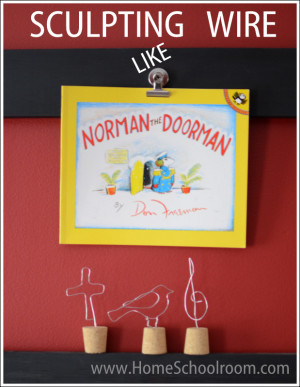
We love the sweet story of Norman the Doorman by Don Freeman. Norman is a hardworking doorman in the basement of a museum. When he isn’t guiding mice through the artistic treasures he pursues his hobby: trying to “create something pleasing or beautiful.” Wouldn’t that be a great pastime for us all?
During the story Norman creates a wire sculpture and enters it into a sculpture contest at the museum. Inspired by Norman’s creation we tried our hand at wire sculpting. I had been wanting to try this with my kids ever since I saw the “Drawing with Wire” article in Family Fun Magazine last year.
For supplies you simply need:
- paper and pencils for sketching your ideas
- wire: you can find it in most craft stores, often in the jewelry section (ours was 20 gauge)
- wire cutters
- something to hold your wire creation like cork or modeling clay, or you can hang your finished product
- safety glasses would have been a good idea (but I forgot)
- needle nose pliers can come in handy, but aren’t necessary
On a way-too-hot-to-be-outside summer afternoon we reread Norman’s story, then gathered at the table to create. We found out it wasn’t as easy as we first thought and why Norman worked “all through the day and far into the night.”
Family Fun’s suggestion of sketching on paper without lifting your pencil helped get our ideas flowing.
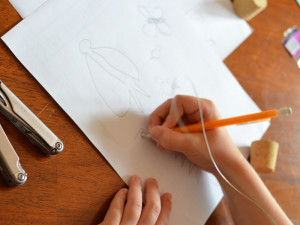
We twisted and bent the wire until we felt we had created something pleasing. The wire was very forgiving–if we didn’t like our shape at first, we just tried again! Leave some wire free for mounting unless you plan to hang your sculpture.
To finish we used a large pushpin to make a hole in the cork before sticking in the free end of the wire. We didn’t find it necessary to mount our corks to a board like the article, they stood just fine on their own.
Norman says “all pieces must have titles” so it was time to name our creations.
My daughter created “Tribute to Treble.”
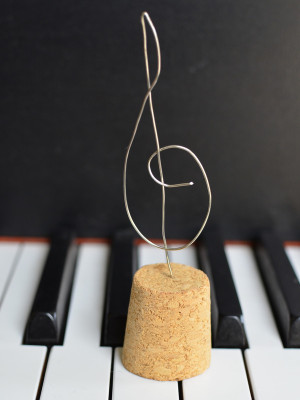
My creation is “Bird in Wire.”
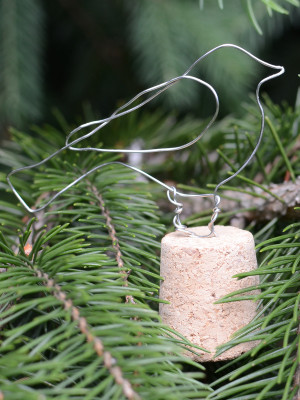
My son’s creation is “The Cross of Jesus.”

It was fun to create something beautiful and we’re very pleased with our results!
This post is part of a fun iHomeschool Network Blog Hop where we’re all sharing A Book and a Big Idea. I know I’ll be looking for more ideas to fill those too-hot or rainy summer days!
2012-2013 End of Year Homeschool Review
Somehow the whole month of June just flew by. It was filled with end-of-school-year celebrations in all our groups and activities…
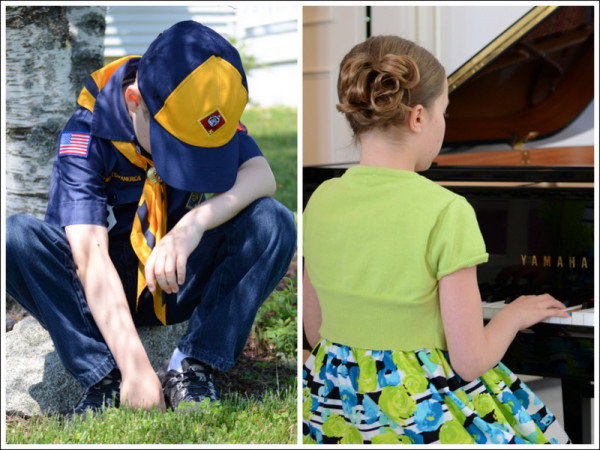
the start of fun summer activities like hiking and camping…
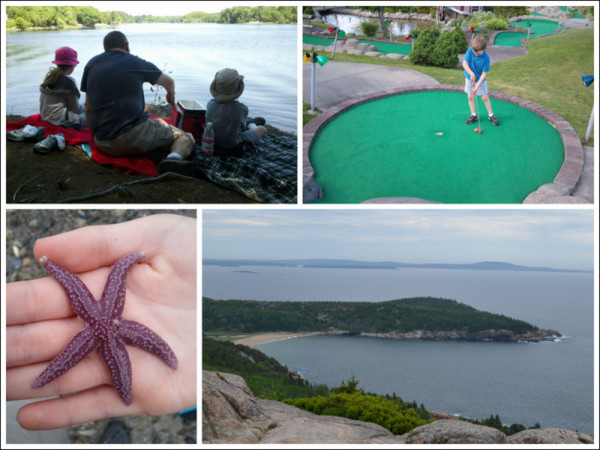
not to mention work like gardening and lawn mowing!
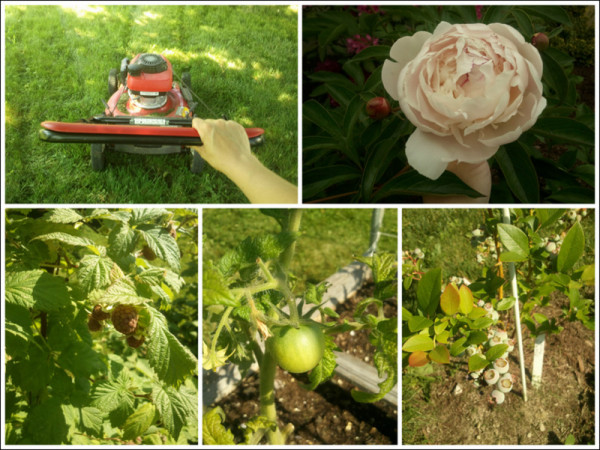
Note to self: Forget about schoolwork for June. Although I allow for a week off and we head out on a camping trip after the drudgery of standardized testing, both last summer and this summer we needed more time before starting our summer school schedule. I did start weekly summer schedules but as far as me sitting down with them working on curriculum or more formal studies, it would be better just to wait for July.
Part of it is because I need to give myself more time to reorganize and ruminate on the successes and failures of the last year. I’ve been thinking so hard my brain hurts, and have so much to say I’ll have to break it up into several posts. So we’ll consider this my first installment: the hits and misses from my 2012-2013 school year plan. In order to be somewhat brief I’ll refrain from going into detail on how I plan to change the things that needed tweaking or didn’t work. You’ll have to stay tuned for my new ideas for next year.
What Worked Well This Year
Core Curriculum
- Writeshop Junior D worked well for my daughter. (You can read my full review of Writeshop on Curriculum Choice.)
- Math: My original plan for my daughter failed early, but our switch to Teaching Textbooks was a hit. For my son lots of playing with math (coin recognition, tally marks, even/odd), working through Life of Fred and an old series of books called “I Love Math” taught basic concepts and we had fun with numbers!
- Funnix helped me teach my son how to read. We finished the last lesson in May and now he’s ready for all the fun beginning reading books at our library. He’s proud of his success and so am I! (Here’s my full review of Funnix on Curriculum Choice.)
- Copywork and Dictation: My ten year old started with copywork from our history curriculum, but towards the end of the year we moved into dictation using selections to address specific areas. I had read about dictation but didn’t fully realize the gold mine of a technique it can be, encompassing skills for writing, grammar, spelling and handwriting.
Extras
- Music lessons: My daughter’s piano lessons are money well spent. They give her a wonderful life skill and have also led to forming a bond with a terrific teacher. (I’m hoping we can find the same experience for my son with guitar.)
- Fine Arts: I added Harmony Fine Arts Grade 1 Overview Year Plans and it made it so easy to accomplish classical music and art appreciation. Secondly, we use the SQUILT technique from Mary of Homegrown Learners to get to know one piece of music at a time. These two resources from fellow homeschool moms help in my weak areas, so the kids and I are learning together.
- Nature Study: Using ideas from Barb at the Handbook of Nature Study blog (and topics that find us) is another highlight of our schoolwork. We did group some of our nature topics into themes and completed detailed studies of trees and birds.
- Unit Studies: Due to my tendency to over-plan and over-complicate, it’s best for me to reserve unit studies for special topics or periods of time. The themed learning sure can be fun, though! This year we enjoyed studies of the U.S. Government and Elections, the Science of Snow, and the Iditarod.
What Didn’t Work This Year
All About Spelling: So many people are huge fans of All About Spelling. I admire the program and can understand all the rave reviews, but it just doesn’t fit us. I still struggled to move through AAS quickly enough to catch up with where my daughter was in her spelling ability. Since it requires 15-20 minutes of one-on-one instruction each day it was too much of a time investment for a single subject that isn’t a struggle for my daughter.
What Needed Some Tweaking This Year
History
I started with a Time Travelers Early 19th Century unit from Homeschool in the Woods, planning to finish by Christmas. Long story short, we got so engrossed we spent the whole year on the 1800s. What worked well was literature-based learning, but two issues put history on the “needs tweaking” list:
- The Time Travelers packs have incredible printables, but those printables required lots of printing and precise cutting and pasting, the beautiful artwork was often too detailed for coloring, and many minibooks had pre-printed text to place inside. In short, they were time-intensive with little room for my kids to make it their own and record what they had learned.
- Not that it isn’t fun to get lost in a time period, but this lasted too long. I think it was due to my aforementioned tendency to over-complicate things, working on those elaborate printables, and choosing time-consuming hands-on projects. In the end our relaxed learning while listening intently to Little House books was what my kids remember.
Science
I still like Real Science Odyssey, but I strayed pretty far from RSO in the second half of the year. I have a science background and my son has an incredible interest in science and asks questions on a daily basis. Contrary to my natural personality, we actually need less structure in science.
Schedules
I love our flexible weekly schedules. What needed tweaking was our outside engagements. By midyear I felt over-scheduled so I cut a couple things out. I have learned to be cautious of signing up for outside activities that place demands on my patience for teaching and planning. Our first year we had a science class where I could sit and chat with other moms while my kids had a great class with a super-excited scientist. Those types of events are better than something I have to help run, which leaves me drained instead of energized.
So that’s the first installment of my review of last year. I still want to share more of my general thoughts as I find myself sharpening my ideas of home education. Do you spend a lot of time reviewing how your year went? Do you get your techniques “figured out” or are you constantly adjusting?
Thank you to the wonderful hostesses with fun wrap-up link-ups. Be sure to join the fun and see what other homeschoolers are up to!
10 Foods to Help You Feel Like a Pioneer

I am a homeschooler and I love to eat, so it should come as no surprise that I like to prepare foods that go along with our studies! I shared about the foods we ate during our study of the 50 States, and today I’m sharing foods we enjoyed during our study of the pioneers of the 1800s.
We actually had a few opportunities to focus on food from this time period: my daughter had a Little House themed birthday party, I shared about pioneer life for her Girl Scout troop, and we invited friends over for a chuck-wagon style dinner as an end of unit celebration.
Snacks and Sides:
1. Homemade Bread: I shared this recipe for simple whole wheat bread during my Tea Time post last week. It really is an easy to make homemade bread even for the novice bread-baker. It’s a great way to show the kids how much different it is to make bread from scratch rather than pick up a loaf at the store.
2. Homemade Butter: I’ve made butter with three groups of kids and it’s not only fun but gives them great insight into the work required for every little thing you ate before the days of supermarkets.
- Put some heavy cream into a glass jar with a tight-fitting lid. I use a canning jar and fill it about half full.
- Then shake, shake, shake! After a while you’ll see whipped cream in your jar.
- Keep shaking until you see yellow lumps.
- Keep shaking until you have a big yellow lump (butter) and some white liquid (buttermilk–save it to make pancakes with the next day!)
3. Canning: This isn’t a recipe for a certain food, but an activity I highly recommend you try with your kids. Make a batch of jam (strawberry, blackberry–anything!) or pickles. We’ve canned a few times and I’m always amazed at the amount of work. We work together on it, it takes half a day and makes a big mess, and we talk about how they had to preserve enough food to last them through the winter. If you’re a total novice, the Ball Complete Book of Home Preserving is a great guide that covers all the basics and has lots of recipes.
4. Cornbread: I’m partial to this recipe for honey cornbread from Allrecipes.com, but would love to try this authentic-looking recipe for Little House style cornbread that adds bacon grease and cooks in a cast iron skillet.
5. Apple Butter: This is a nice treat on a slice of homemade bread. We made ours in the oven using a recipe from American Kids in History: Pioneer Days (a great book, by the way, with lots of ideas for things to make, do, and eat). Allrecipes.com has a recipe for apple butter that cooks in the crockpot.
Main Course
A full pioneer style dinner calls for a simple and filling main course.
6. Beef Stew: Again, if we’re using bullion we’re cheating a bit, but this recipe for a fairly simple beef stew is a satisfying main course.
7. Baked Beans: This simple recipe for baked beans has ingredients pioneers might have had on hand. We use a recipe from my husband’s Aunt Alice. Hopefully I don’t get in trouble for giving out a secret family recipe!
- 2 pounds soldier beans
- 1/2 pound salt pork
- 1 medium onion
- 2 tsp dry mustard
- 3/4 cup brown sugar
- 1 1/2 cup maple syrup
- 1/2 cup molasses
Soak the beans overnight. In the morning boil them for 5-7 minutes. Add everything to a bean pot, add water just to cover and bake for 8 hours at 275 degrees. We don’t have a bean pot so we use a crock pot on low for 8-10 hours.
A Sweet Ending
8. Apple Pandowdy: I tried this recipe for Pandowdy. It’s sort of like a cobbler though messier looking, but in a bubbly and delicious sort of way.
9. Sugar on Snow: We had actually tried sugar on snow during our Maple Syrup unit study.
10. Pie, with a homemade crust: Does any one else love the convenience of the easy unroll-and-bake refrigerated pie crusts? For the pioneer experience make a pie crust from scratch and have the kids help you with the whole messy job. Fill it with apples or pumpkins (if you’re really adventurous you could skip canned pumpkin and prepare the pumpkin yourself) or for a main course try chicken pot pie. This pie crust recipe I learned at a pie-making class. (And forgive me for the shortening. I do try to avoid it!)
- 4 cups flour
- 1/2 cup sugar
- 1 teaspoon salt
- 1 3/4 cup shortening
- 1 egg
- 1 1/2 teaspoon lemon juice
- 1/2 cup water
Mix flour, sugar, salt and shortening by hand until it crumbles. Add wet ingredients just until mixed. Roll out and proceed with your yummy pie recipe. Makes four crusts.
Don’t forget to enlist your kids’ help preparing these foods from scratch–they’ll understand a little more about life for children during that time period. In truth we aren’t even getting the full experience since we didn’t have to grow and thresh the wheat to make our flour, or slaughter the animals, and Ma Ingalls certainly didn’t have nicely ground dried spices from the store or canned chicken stock. It may not be fully authentic but it helps us understand how much work was involved in making all their food–and that children had to help!
Hop over to iHomeschool network to see what other homeschool bloggers are cooking up.
This blog hop series was inspired by Angie of Many Little Blessings where you’re welcome to link up, too!
Scheduling Tea Time for the Extras and 10 Tea Time Snacks
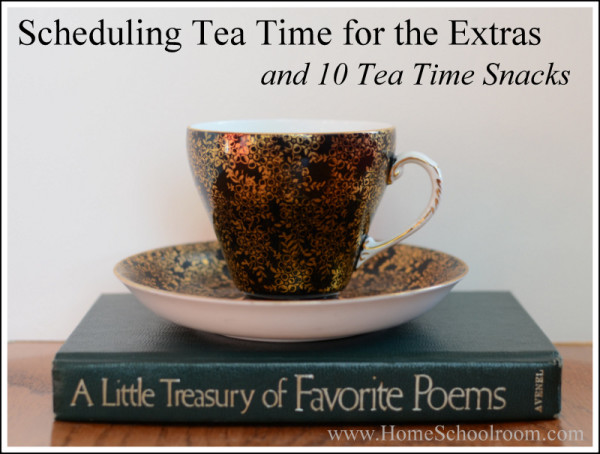
As I’ve been taking the time to reflect on our last school year and iron out what my goals and plans are for next year one thing I’m really excited to institute is a tea time. I’m planning to use it as a time to focus on those lovely “extras” that are a hallmark of the Charlotte Mason style education. We’ll sit down together over a cup of tea and a treat and share poetry and fine art and music.
Anytime I read about other homeschool moms setting aside tea time I liked the idea of making it a special time in our day. Then when I read about Elevenses from Ellen at the Bluestocking Belle I realized the 11:00 time slot would be a good fit for us, too. It will work better than an afternoon tea-time, because often by afternoon we’re either heading to an activity or errands or I’m settling them in for Quiet Time (a daily habit I can’t do without). It also will be a good time to transition between their individual work that starts our day and the subjects we study together.
Step #1 to make this a special time to look forward to in our schedule is having a sweet edible treat. I’m conscious of it being a treat, but not too unhealthy. And although I enjoy baking some days are too busy and I don’t like to have large amounts of sweet baked goods in the pantry (because then I’m tempted to eat them all day long). My answer to those problems are baking things I can freeze. That way we’ll only keep out a little for our tea time and it will also give us variety because every few days we can pull something different from the freezer.
From A to Z here are my go-to freezer-friendly sweet treats I plan to keep stocked for our tea time.
#1 Apple Bread
I use the Apple Walnut Bread recipe from Allrecipes.com, minus the walnuts because my kids don’t like them. I just love the rustic nature of this sweet bread with chunks of apple. I cut the calories a bit by decreasing the oil to 1/2 cup and increasing the applesauce to 1/2 cup. The recipe yields two loaves.
#2 Banana Bread
This recipe comes from an old Canadian cookbook treasured by my mother. I made a few substitutions to make it a bit healthier and everyone still asks for the recipe. This recipe also yields two loaves.
- 2 cups mashed overripe bananas (5-6 bananas)
- 1 1/2 cups brown sugar
- 4 eggs
- 1/2 cup melted butter
- 1/4 cup applesauce
- 1 cup wheat flour
- 2 cups white flour
- 1/2 teaspoon salt
- 2 teaspoons baking soda
- 1 teaspoon vanilla
Mix bananas, sugar and eggs. Add butter, applesauce and vanilla; mix well. Sift together flour, salt and soda. Add to wet ingredients and mix well but don’t over-mix. Bake at 350 degrees for 45 minutes or until a toothpick inserted near the center comes out clean.
#3 Blueberry Muffins
These Blueberry Cream Muffins from Allrecipes.com are a family favorite. I use half brown sugar and half white sugar, and also increase the blueberries to 3 cups (you can add frozen berries right to the batter). It makes 24 muffins so I freeze as many as I can. After thawing I microwave them to make sure they are warm through, then pop them into the toaster oven for a minute–after that you’d swear they were fresh baked.
#4 Cinnamon Raisin Bread
This delicious homemade recipe for Cinnamon Raisin Bread from Allrecipes is a bit more work than most of these treats, but quite delicious. I cut the ingredients in half (because otherwise I think it would overload my Kitchenaid mixer) and it still makes two loaves. It does bake in less than the 45 minutes the recipe calls for, so be sure to check your bread early.
#5 Cranberry Bread
Have you every read Cranberry Thanksgiving? It’s a cute story, and on the back is the recipe for Grandma’s Famous Cranberry Bread. I’d tried several recipes before this that were not what I was looking for–this one is just right–just enough tart cranberry and orange flavor.
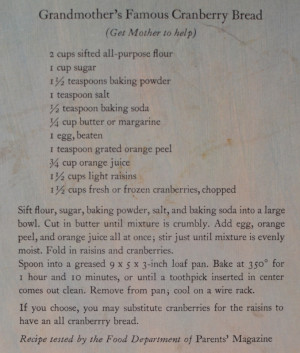
#6 Pumpkin Bread
This recipe for Downeast Maine Pumpkin Bread is terrific. And I’m not saying that just because I’m from Maine–I’m backed up by the 5,000 people who have reviewed it! It makes three loaves, so there is plenty to freeze.
#7 Rhubarb Bread
Every old garden in Maine has rhubarb growing in it. This recipe that was once listed in a local newspaper makes a delicious sweet bread from the tangy stalks.
- 1 1/2 cups packed brown sugar
- 2/3 cup vegetable oil
- 1 egg
- 1 cup buttermilk
- 1 tsp. salt
- 1 teaspoon baking soda
- 1 teaspoon vanilla
- 2 1/2 cups flour
- 2 cups diced rhubarb
Mix brown sugar and oil until smooth. Add egg, buttermilk, salt, soda, vanilla and flour. Blend until moist. Fold in rhubarb. Pour into two greased loaf pans and bake at 350 degrees for 50-55 minutes or until a toothpick inserted near the center comes out clean. (By the way, if you don’t have buttermilk just put one tablespoon of vinegar into a measuring cup, add milk to make 1 cup total liquid and let stand for 5 minutes before using.)
#8 Scotch Tea Muffins
These are plain muffins that are perfect for pairing with homemade jam. The recipe came from an old Canadian cookbook my mother treasures.
- 2 tablespoons butter
- 1 egg
- 4 cups flour
- dash salt
- 1 1/4 cups sugar
- 1 1/4 cups milk
- 4 teaspoons baking powder.
Mix dry ingredients. Then add wet ingredients. Bake at 350 degrees fro 15-20 minutes.
#9 Whole Wheat Bread
I love this Simple Whole Wheat Bread recipe from Allrecipes.com. It makes three loaves so the work involved really pays off and I’ve had wonderful luck with it. When I first started making it I tried freezing the dough before it rose at all, freezing after the first rise and freezing after it was baked. The already baked bread tasted wonderful from the freezer and the bonus: that was the easiest, too, because it can be taken right out of the freezer, thawed and enjoyed just like fresh baked. If anyone has frozen store-bought bread before you may notice the texture suffers after you thaw it. This is not the case with homemade bread–trust me!
#10 Zucchini Bread
And last, but certainly not least, a recipe for Zucchini Bread from Allrecipes.com. If your children balk at the idea just feed it to them first before you tell them what’s in it. My children love this bread.
What Will We Do During Tea Time?
- We’ll read poetry aloud with a goal of memorizing one poem each month.
- Homeschool Share has regular Tea Time posts with information and links for studying poets, composers, and artists.
- These next two resources have helped expose and educate me along with my children in subject areas that were challenging for me. I had almost no experience or knowledge in fine art and music and these resources from fellow homeschool moms are invaluable.
- Fine art and music appreciation is planned for you with Harmony Fine Arts. We’ll be using Grade 5 this year to go along with our history studies.
- Mary from Homegrown Learners shares her classic music appreciation technique of Super Quiet UnInterrupted Listening Time. I’m an affiliate for her just-released ebook with 10 SQUILT lessons because I honestly love this resource. The information she shares on each piece of music is crucial for me to share intelligently with my children. Click here to visit Homegrown Learners.
Hop over to iHomeschool network for more top ten lists.
This blog hop series was inspired by Angie of Many Little Blessings where you’re welcome to link up, too!
Summer Habit Training with a Weekly Schedule
After finishing up our second year of homeschooling with a week of testing, it was time for some relaxation. So for the past two weeks we’ve spent some time on the beautiful coast of Maine and taken some walks in the woods to refresh.
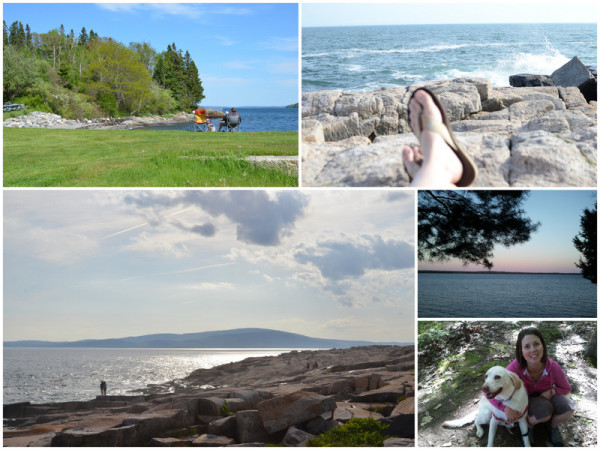
It was a great time for reflection on the past year–what went well and what needs some tweaking. I’ve been reading (and rereading) some of my favorite homeschooling books and grabbing some inspiration from my favorite blogs.
Time for Some Habit Training
Those of you familiar with Charlotte Mason’s methods know that a tool she advocates is the use of habits, and this is an area where we need some work. Which is really to say that I, as the mother, need some work.
The mother who takes pains to endow her children with good habits secures for herself smooth and easy days; while she who lets their habits take care of themselves has a weary life of endless friction with the children. ~ Charlotte Mason (Volume 1, p. 136)
I am often inspired by Barb’s wise council as a Charlotte Mason style homeschooler just graduating her third child. A post she wrote about instilling habits in her older children is full of ideas and advice and prompted me to focus on some housekeeping habits during our more relaxed summer schedule. I have been working on chores with my children, attempting to line up their responsibilities for taking care of their spaces and belongings and also contribute to overall household cleanliness. We have made some headway:
- They each have a checklist for getting ready in the morning, which is helpful in cutting down the numbers of times I have to say “Did you pick up your dirty clothes?” or “Did you turn off your bedroom light?” I still find myself having to remind them to go check their list for forgotten items, however, and with the list posted upstairs I can forget my responsibility to see that they have checked off the items. There is no record from day to day, so I feel the lines of habit have not been laid firmly enough for these daily tasks to become second nature.
- I added a daily household chore for each child. These are different each day and involve things like sweeping or wiping down bathroom counters and when done they really help keep the house cleaner during the week before my rounds of weekend deeper cleaning. I kept the list of specific chores on my desk, so here again I found myself forgetting to remind them and many days the chores went undone.
The room for improvement is making these tasks that they are fully capable of into a habit with no need for reminding by me. Taking care of these habits over the summer should let us focus on other habits when full time schoolwork picks up in the fall.
Last year I used a checklist for my daughter to increase independence in her school work and it worked very well. I modified the lists and made each of my children a summer weekly checklist.
Summer Weekly Schedule Checklist
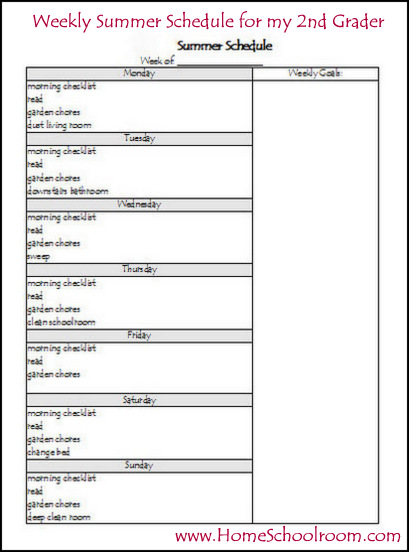
Each of them has daily tasks on their schedule:
- Morning checklist: the hope is this will cut down on me having to remind them to complete this list.
- Read: they have reading goals specific to their age, and this is here to make sure each of them reads every day.
- A household chore: again, with the item on their checklist I hope to cut down on the need for reminders from me.
- Garden chores: they each have their own square foot garden, so they need to weed and water it each day. My daughter showed extra interest in flowers this year so she also has several potted plants outside that will be her responsibility.
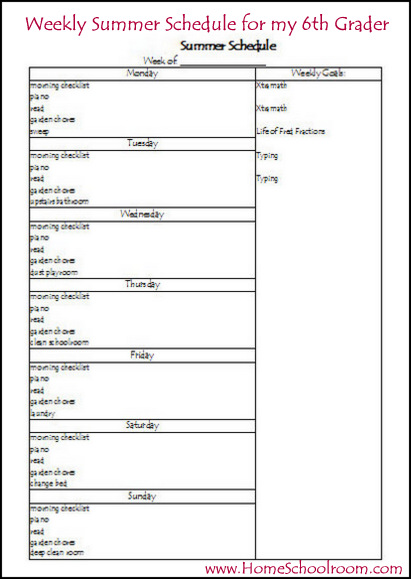
My daughter’s list has additional items:
- Daily piano practice
- Some tasks that need to happen 1-3 times per week but the day is up to her (Xtramath, a chapter in Life of Fred, and typing practice)
- I also plan to check in with her each Monday to help her in setting some personal goals she can add under “weekly goals.” I found this helps keep her productive in her free time. We set goals like making something (she sews and loves duct tape crafting) or organizing a section of her room (something she actually enjoys!) or writing a letter to someone (she has several girls she exchanges letters with).
These checklists give us all a central place to keep track of chores and also keep a record of how they are doing at accomplishing each item each day. The final piece is a reward for weekly lists with all items checked off. I’m still debating the specific reward–a trip to Dunkin’ Donuts for breakfast, or possibly good old cash.
In case any of you are also looking to make your life with your children easier by forming good habits Simply Charlotte Mason offers a free ebook that I just stumbled across today called Smooth and Easy Days. Do you have any specific summer goals for your children or any advice for me as we focus on habits?
Thank you to the wonderful hostesses with fun link-ups. Be sure to join the fun and see what other homeschoolers are up to!
10 Homeschooling Books to Encourage and Equip
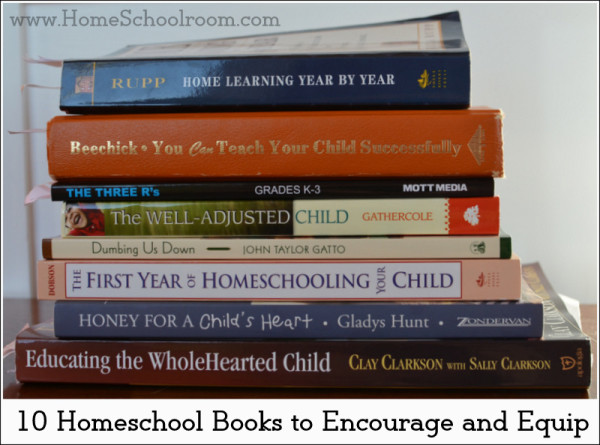
It’s time for another Top Ten post and the topic this week is homeschooling books. I am by no means an expert in this area and still wish I could take a month off just to read more books about homeschooling! In fact, that’s what I’ve been doing since we officially finished our school year about a week and a half ago. I want to share some of my favorites, which fall into two categories: the books that encouraged me to homeschool and those that equipped me to do it.
By the way, the book titles are Amazon Affiliate Links, but these are books I truly enjoyed.
#1 The Well-Adjusted Child: The Social Benefits of Homeschooling by Rachel Gathercole
Don’t laugh, but one of my arguments against homeschooling (you know, before I became one of those weirdos) was that kids had to go to school for socialization. My husband ordered several books when I was hyperventilating over the prospect of homeschooling and this was the first book I read. It opened my eyes to the fact that a bunch of same age kids in a room doesn’t lead to the kind of social skills I’m looking to create.
#2 Dumbing Us Down: The Hidden Curriculum of Compulsory Schooling by John Taylor Gatto
This was my second book, and my second a-ha moment. This was the one that I kept stopping as I was reading and remarking to my husband that we had to homeschool! It’s a fairly quick read at around 100 pages but really highlighted for me the negative aspects that can be found in public schools. (For example, changing subjects to the ringing of a bell makes no sense whatsoever in the real world.)
#3 The First Year of Homeschooling Your Child by Linda Dobson
Now that the first two books had convinced me that I did, indeed, want to homeschool my children, this was the first book I read that made me think I could actually accomplish it. My favorite parts of the book were many stories from homeschool families and the examples of different homeschool philosophies so I could begin to formulate my plan for educating my children. The book also deals with a lot of practical newbie help like taking a child out of public school (and the de-schooling that can be necessary) and learning styles.
#4 Home Learning Year by Year by Rebecca Rupp
This is another very practical choice. There is a chapter for each grade from preschool through high school, and each one details a course of study and even lists resources for covering the subjects. I continue to refer to this book, especially for math concepts to see that we’re covering age-appropriate skills. I appreciate the wide range of resources listed, from books to manipulatives to games to standard curriculum.
#5 Honey for a Child’s Heart by Gladys Hunt
Okay, so this isn’t actually a homeschooling book, but it had an impact on my homeschooling style and continues to be a reference I turn to so I wanted to list it here. Like the Read Aloud Handbook by Jim Trelease (which I also enjoyed, but comes in second to this book) it encourages reading aloud to children and sharing books as part of your family life. The first portion of the book discusses books and their importance, how to encourage your children to read and choosing books. The second half of the book contains book lists organized by age and topic. I have come to really trust her choices and the paragraph describing each book.
#6 Charlotte Mason’s Original Homeschooling Series
Though I am fairly eclectic in my homeschooling I admire many of Charlotte Mason’s philosophies and incorporate as much of them as I can. I have to admit I have not finished reading all six books in her original series. This is reading I save for when my brain is fresh and focused. I purchased the Kindle version once when it was available for around a dollar on Amazon so it was very little to spend to have her writing easily accessible. When I get a chance I read a few pages and I also use the highlight feature to keep track of particularly interesting or beneficial sections. Her original series and modern paraphrases are available for free online at Ambleside.org.
#7 For the Children’s Sake by Susan Schaeffer Macaulay
This book gave me an tremendously helpful overall idea of Charlotte Mason’s philosophy and helped me better understand the primary focus areas of her method. Understanding those primary areas gave me direction in planning my homeschool priorities.
#8 A Charlotte Mason Companion by Karen Andreola
This book is quite a bit longer but filled with practical advice on implementing every part of a Charlotte Mason style education. I read a copy from the library but intend to add it to my bookshelf so I can highlight and stick sticky notes in it and refer to it.
#9 Educating the WholeHearted Child by Clay and Sally Clarkson
I’d had my eye on this book for a while after reading many accolades, but was holding off because it wasn’t available at the library. I finally bought a copy and am glad I did–it is a large book loaded with information on many aspects of child-rearing and homeschooling. It is very much Christian-focused, which would come as no surprise to anyone familiar with the Clarksons. Their homeschool method has much in common with Charlotte Mason, and this book has a very practical modern-day focus for raising children today. My favorite parts are the focus on living books, natural and gentle education methods, and making your home work for your in your goals.
#10 The Three R’s and You Can Teach Your Child Successfully by Ruth Beechick
These are my newest reads and they easily joined my list of favorites. I found myself getting a little bogged down this year in long to-do lists and obsessing about curriculum choices and schedules. Ruth Beechick’s advice is so very practical and down to earth it would be hard not to be calmed by her style. The Three R’s covers Kindergarten to 3rd grade, while You Can Teach Your Child covers grades 4-8. Going over these books has already helped me simplify some of my plans for next year.
I love reading homeschooling books to fine-tune my style and encourage me in this lifestyle. What books have you loved that I should add to my summer reading pile?
I can’t wait to read the book lists of the other bloggers of iHomeschool network. Every Tuesday for the next 10 weeks I’ll be participating with the other bloggers of iHN in a blog hop of top ten lists.
This blog hop series was inspired by Angie of Many Little Blessings where you’re welcome to link up, too!
Learning about the Life of Anne Frank
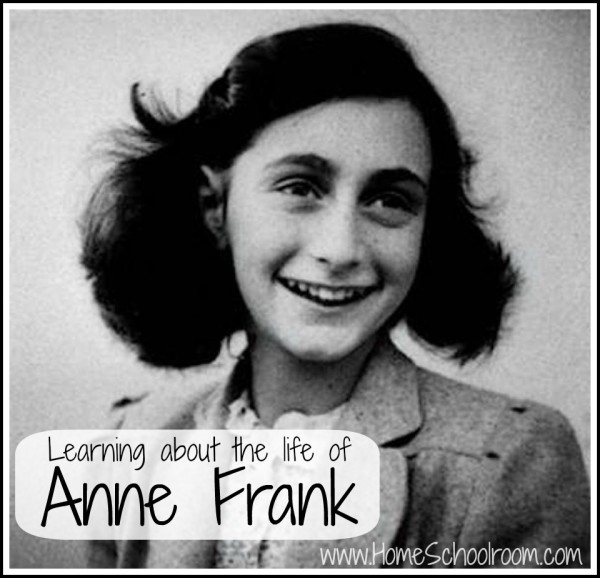
Anne Frank is the face of the Holocaust for many people who have read her diary. She was born on June 12th, 1929, so in participation with the June famous birthdays blog hop for iHomeschool Network I put together some ideas for introducing Anne Frank to your children.
Anne’s story puts a personal touch on the atrocities of the Holocaust. Instead of just reading numbers that are almost too large to imagine, and hearing that even children died, your children are meeting one of those children.
A child who had the same hopes and dreams they do.
A child who lived in fear and hiding for two years.
A child whose story does not have a happy ending.
The sad ending may be the most difficult part to handle, but I think it is also what gives my children the truest connection to a story that should never be forgotten. Fortunately there are wonderful books about Anne Frank’s life written for a wide range of ages.
The book titles are Amazon affiliate links, but I always give my honest opinion of products.
A Picture Book of Anne Frank by David A. Adler
This warmly illustrated picture book is a good introduction to Anne Frank’s story for elementary children. The story also provides an overview of Hitler and the persecution of the Jews under his regime. There is no sugar-coating of the atrocities, and there is a haunting painting of Anne and her sister frail near the end of their lives, but I believe the lack of real photographs keeps it easier to handle for young children.
Who Was Anne Frank? by Ann Abramson
This is a chapter book biography about Anne Frank written in 2007. I did not enjoy the writing style of short choppy sentences or the pencil sketch illustrations, but I did appreciate much of the content. This book provides a lot of information about the war and events happening throughout the region, and has more details than the other books I reviewed about restrictions placed on Jews. The information on what happened after the Frank family was discovered hiding is less detailed and more cursory.
Anne Frank, Life in Hiding by Johanna Hurwitz
This chapter book biography written in 1988 has details about the actions of the Nazis and persecution of the Jews–personalized by telling what Anne went through during these events, from wearing a yellow star to going into hiding in the place she named The Secret Annex. The illustrations are very detailed pencil drawings. This book shares many more details on the difficulties Anne faced as an adolescent in hiding and her personal struggles. It tells the story of Anne’s life after the Gestapo discovered the people in the Secret Annex and her family was sent to various concentration camps and about the publishing of her diary.
Anne Frank: The Diary of a Young Girl
This is the book through which the world came to know Anne so well. It is a lengthy book of her diary entries beginning on her thirteenth birthday, just before her family went into hiding, and ending just before their arrest by the Gestapo. In her own voice you read the emotional difficulties that were on one hand typical of a girl becoming a young woman but on the other hand amplified by the incredible stress Anne was under and the pressures of life in hiding. It is Anne’s actual diary entries, so your personal relationship with Anne is even deeper. There are details about her often difficult relationships with the other occupants of the Secret Annex, including Peter, the young man she grew to love. I would say it is best suited for middle schoolers and up–children in the age range Anne was when she wrote her diary. The afterword shares the story of what happened to Anne after her arrest and how her diary came to be published. Anne Frank: The Diary of a Young Girl, edited by Otto H. Frank and Mirjam Pressler, is the newer version that contains entries that had been cut from the previous editions.
These next two books were both done in cooperation with the Anne Frank house and are filled with many of the same photographs of Anne’s life before hiding, the Secret Annex and the others who hid there, the people that helped them hide, and Anne’s diary entries.
Anne Frank: Beyond the Diary, A Photographic Remembrance by Ruud van der Rol and Rian Verhoeven
The primary text for this book reads like a story and centers around Anne’s life and diary entries, while also telling the stories of the Holocaust and war. The photographs of people wearing yellow stars, emaciated prisoners, “Jews Forbidden” signs, food rationing coupons, and even the document listing the Frank family’s transport to Auschwitz bring a haunting reality to the text. The book shares information about the concentration camps and heart-wrenching photos including children that were sent to the gas chamber and starving prisoners. The book wraps up by telling of Anne’s death, the end of the war, her father’s life after the war (he was the only survivor from the Secret Annex) and the publishing of her diary.
Anne Frank: Her life in Words and Pictures from the archives of The Anne Frank House
This newer version includes a collection of color photos of the Secret Annex when it was refurnished for a film, extra details about Anne’s life in the prison camps from witnesses there with her, and additional concentration camp photos (including dead bodies being piled). This book is a smaller size than the previous book, and is set up more like a scrapbook. There are a few pages of text now and then, but it reads less like a story and more of the information is found in large captions for the photos. Brief information about Hitler, the Holocaust, Germany and the Netherlands is included in a glossary at the back of the book instead of along with the primary story.
For our homeschool we’ll be learning about Anne as we study World War II, and I will keep the study of her life simple. My children will read the books suited to their ages, we’ll go through selected pictures from the photographic books, and they’ll each complete a notebook page. (There are two free versions at Activity Village, just scroll down alphabetically to her last name.) We will step into this amazing story as deeply as each of my children can handle it and let Anne’s story touch our hearts.
Hop over to learn about other fascinating people born in June from the bloggers of iHomeschool Network.
